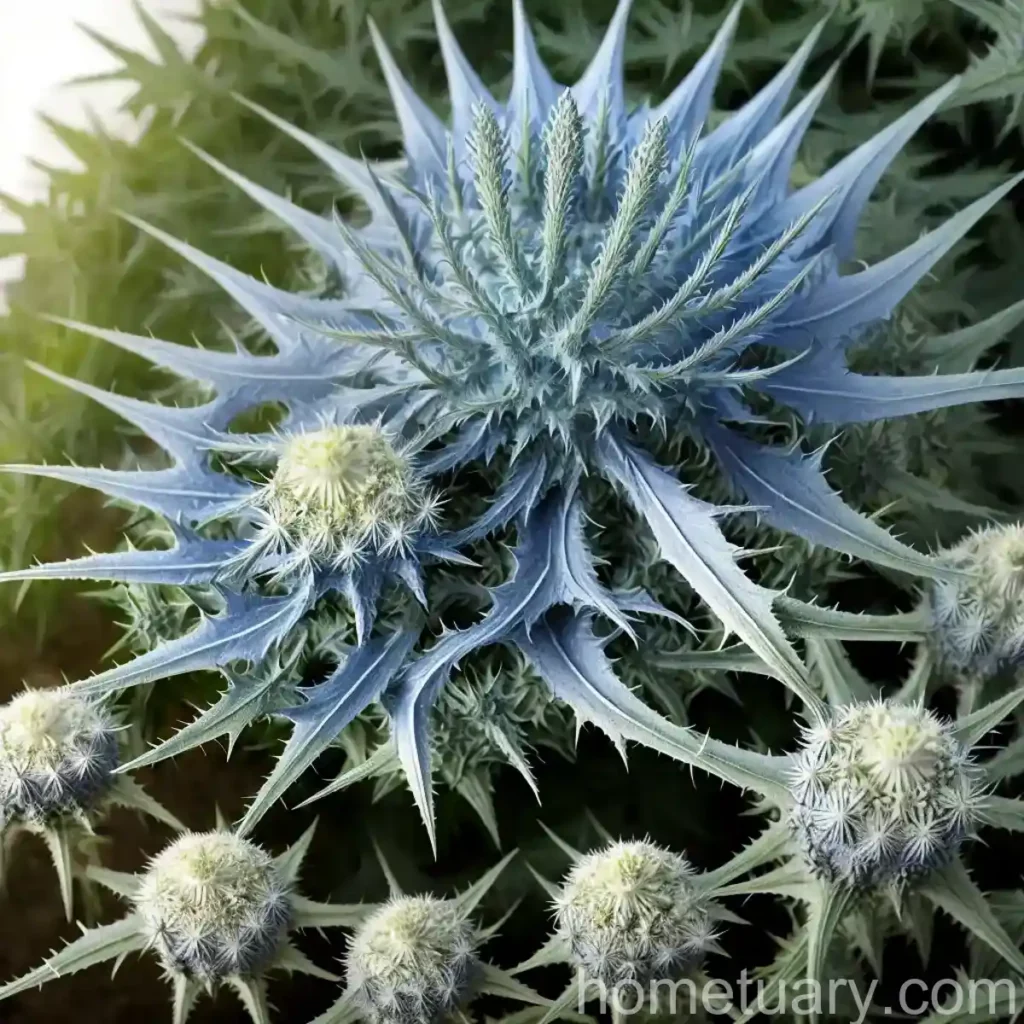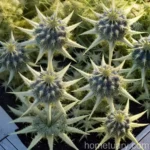Sea Holly (Eryngium x zabelii ‘Big Blue’): A Complete Care Guide
Introduction
Sea holly, scientifically known as Eryngium x zabelii ‘Big Blue’, is a striking perennial that is valued for its unique appearance and versatility in the garden. This plant is native to rocky and coastal areas, and it is well-adapted to thrive in challenging conditions. Its stunning silver-blue spiky bracts and globular flowers make it a favorite among gardeners and landscapers.
In this comprehensive guide, we will delve into the essential aspects of sea holly, including its culture, uses, water and sunlight requirements, fertilizer, soil preferences, pruning techniques, propagation methods, common diseases, pests, as well as botanist’s tips and fun facts. By the end of this guide, you will gain valuable insights into the care and cultivation of sea holly, enabling you to incorporate this beautiful plant into your landscape with confidence.
Key Takeaways – Sea Holly (Eryngium x zabelii ‘Big Blue’)
To provide a quick overview, here are the key takeaways about sea holly, Eryngium x zabelii ‘Big Blue’:
- Scientific Name: Eryngium x zabelii ‘Big Blue’
- Common Name: Sea Holly
- Plant Type: Perennial
- Flower Color: Silver-blue
- Sunlight: Full sun to partial shade
- Watering: Low to moderate water requirements
- Soil Type: Well-draining, sandy or loamy soil
- Height and Spread: 2-3 feet tall, 1-2 feet wide
- Hardiness Zone: 4-9
- Uses: Cut flowers, landscaping, wildlife gardens
- Unique Features: Spiky silver-blue bracts, tolerance to coastal conditions
Now, let’s dive into the specifics of caring for sea holly, from its cultural preferences to propagation methods, and everything in between.
Culture
Uses
Sea holly, Eryngium x zabelii ‘Big Blue’, offers a wide range of uses in landscaping, gardening, and even traditional medicine. Below are some of its primary uses:
-
Landscaping: Sea holly adds an interesting texture and color to borders, rock gardens, and coastal landscapes. Its unique appearance makes it an excellent choice for xeriscaping projects.
-
Cut Flowers: The intriguing, long-lasting blooms of sea holly are prized in floral arrangements and can be dried for ornamental use.
-
Wildlife Gardens: The flowers of sea holly attract pollinators such as bees and butterflies, making it a valuable addition to wildlife-friendly gardens.
-
Medicinal Uses: While not extensively documented, Eryngium species have been traditionally used in herbal medicine for various purposes, including anti-inflammatory and diuretic properties.
Water
Sea holly generally thrives in well-draining soil and can tolerate periods of drought once established. It is crucial to allow the soil to dry out between waterings to prevent root rot and other moisture-related issues.
-
Watering Frequency: In the initial establishment phase, water newly planted sea holly regularly to promote healthy root development. Once established, reduce watering to occasional deep soakings during prolonged dry spells.
-
Watering Technique: Water at the base of the plants to minimize moisture on the foliage, which can help prevent fungal diseases.
Sunlight
Sea holly performs best in full sun to partial shade, where it can receive at least 6-8 hours of direct sunlight daily. In hotter climates, providing some afternoon shade can be beneficial to prevent scorching of the leaves.
-
Sunlight Requirements: Ensure that sea holly is planted in a location that receives adequate sunlight to promote robust growth and flowering.
-
Shade Tolerance: While sea holly prefers full sun, it can adapt to partial shade conditions, especially in regions with intense heat.
Fertilizer
In general, sea holly is not overly demanding when it comes to fertilization. However, providing some nutrients can support its growth and flowering performance.
-
Fertilizer Type: Use a balanced, slow-release fertilizer in spring as new growth emerges. Avoid excessive nitrogen, as this can lead to lush foliage at the expense of flowers.
-
Application Technique: Apply the fertilizer according to the manufacturer’s instructions, and water thoroughly after application to distribute the nutrients into the soil.
Soil
The right soil environment is crucial for the health and vitality of sea holly. This plant prefers well-draining, sandy or loamy soil and can adapt to various soil pH levels.
-
Soil Texture: Sandy or loamy soil that drains well is ideal for sea holly. If the soil is heavy or compacted, amending it with organic matter such as compost can improve drainage.
-
pH Level: Sea holly is adaptable to a wide range of soil pH levels, but it generally thrives in slightly acidic to neutral soil (pH 6.0-7.5).
-
Soil Moisture: Avoid waterlogged conditions, as this can lead to root rot. Ensure that the soil allows excess water to drain away effectively.
Pruning
Proper pruning and maintenance can help sea holly maintain a tidy and attractive appearance while promoting vigorous growth and flowering.
-
Deadheading: Remove spent flowers regularly to encourage continuous blooming and prevent the plant from expending energy on seed production.
-
Cutting Back: In late winter or early spring, cut back the previous year’s growth to a few inches above the ground to make way for new growth.
-
Tidying Up: Trim away any damaged or discolored foliage throughout the growing season to keep the plant looking neat and healthy.
Propagation
Sea holly can be propagated through various methods, including division, seed sowing, and root cuttings. Each propagation technique offers unique advantages and is suited to different situations.
-
Division: Divide mature sea holly plants every few years in early spring to rejuvenate the clumps and create new plants. Ensure that each division has a good root system attached.
-
Seed Sowing: Collect seeds from mature sea holly plants and sow them in a well-prepared seedbed in spring. Keep the soil consistently moist until the seeds germinate, and then transplant the seedlings once they are large enough.
-
Root Cuttings: Take 3-4 inch long root cuttings in late winter and plant them in a propagation medium. Keep the cuttings consistently moist and warm until new shoots emerge.
Container Popularity
Sea holly is well-suited to container gardening, where its unique appearance can be showcased on patios, balconies, and other outdoor spaces.
-
Container Size: Choose a container with sufficient depth and width to accommodate the root system of sea holly. A container that is at least 12-18 inches in diameter and depth is recommended.
-
Drainage: Ensure that the container has adequate drainage holes to prevent waterlogging, and use a well-draining potting mix to promote healthy root growth.
-
Maintenance: Container-grown sea holly may require more frequent watering than those in the ground, as the soil in containers can dry out more quickly.
Common Diseases
Like all plants, sea holly is susceptible to certain diseases, particularly if grown in conditions that are not ideal for its health and vigor.
-
Powdery Mildew: This fungal disease can affect sea holly, causing a powdery white coating on the leaves. Ensure good air circulation and avoid overhead watering to prevent powdery mildew.
-
Root Rot: Excessive moisture or poorly draining soil can lead to root rot in sea holly. Planting in well-draining soil and allowing the soil to dry out between waterings can help prevent this issue.
-
Crown Rot: Overwatering or waterlogged soil can lead to crown rot, which affects the base of the plant. Avoid excess irrigation to prevent this condition.
Disease Diagnosis
Diagnosing and addressing plant diseases promptly is crucial to prevent the spread of infections and minimize the impact on sea holly’s health.
-
Symptoms: Look for signs of discoloration, wilting, or unusual growth on the leaves, stems, or flowers of sea holly.
-
Treatment: If you suspect a disease, isolate the affected plant to prevent it from spreading to others. Depending on the specific disease, treatments such as fungicides or adjusting cultural practices may be necessary.
-
Prevention: Implement preventive measures such as providing proper air circulation, avoiding overhead watering, and maintaining suitable soil moisture levels to minimize the risk of diseases.
Common Pests
Sea holly is relatively resistant to pest infestations, but it may occasionally attract certain insects that can cause damage if left unmanaged.
-
Aphids: These small, soft-bodied insects may cluster on the new growth and flower buds of sea holly, sucking sap from the plant. They can be dislodged with a strong spray of water or controlled with insecticidal soap.
-
Spider Mites: These tiny pests can cause stippling and webbing on the leaves of sea holly, especially in hot, dry conditions. Regularly spraying the foliage with water can help deter spider mites.
-
Slugs and Snails: These pests may feed on the foliage of sea holly, leaving behind irregular holes. Use physical barriers or organic slug control methods to protect the plants.
Botanist’s Tips
As a botanist, I have observed and studied the fascinating characteristics of sea holly, Eryngium x zabelii ‘Big Blue’, and have some essential tips to share for successful cultivation.
-
Coastal Adaptability: Sea holly’s natural habitat in rocky and coastal areas makes it well-adapted to thrive in challenging conditions, including sandy or gravelly soils with minimal moisture.
-
Pollinator Attraction: The distinctive flowers of sea holly are magnets for pollinators, making it a valuable addition to wildlife-friendly gardens and habitats.
-
Drought Tolerance: Once established, sea holly exhibits impressive drought tolerance, making it an excellent choice for water-wise landscaping projects.
-
Cut Flower Potential: The intriguing, long-lasting blooms of sea holly make it a standout choice for cut flower arrangements, both fresh and dried.
Fun Facts
Sea holly, Eryngium x zabelii ‘Big Blue’, is not only a visually striking plant but also offers several intriguing aspects that make it a captivating addition to gardens and landscapes.
-
Symbolism: In the language of flowers, sea holly symbolizes admiration and strength, making it a meaningful choice for bouquets and floral gifts.
-
Historical Uses: Throughout history, different species of Eryngium have been used for various purposes, ranging from culinary and medicinal to ornamental and even superstitious.
-
Wildlife Magnet: The flowers of sea holly are highly attractive to bees, butterflies, and other pollinators, enhancing biodiversity and ecological balance in the garden.
-
Structure and Texture: The spiky, silvery-blue bracts of sea holly add a unique architectural element to landscapes, providing contrast and interest.
Links to External Resources
For further information and inspiration on sea holly, Eryngium x zabelii ‘Big Blue’, explore the following external resources:
- RHS – Growing Eryngium
- Missouri Botanical Garden – Eryngium x zabelii
- University of Florida IFAS Extension – Sea Holly
- Gardening Know How – Sea Holly Growing Conditions
Conclusion
Sea holly, Eryngium x zabelii ‘Big Blue’, is an exquisite perennial that captivates with its silver-blue spiky bracts and globular flowers. This plant’s adaptability, low maintenance requirements, and unique visual appeal make it an outstanding choice for a wide range of garden styles and landscaping projects.
By understanding and implementing the cultural preferences, uses, water and sunlight requirements, soil considerations, pruning techniques, propagation methods, and pest and disease management strategies for sea holly, you can cultivate and enjoy this striking perennial with confidence and success.
I hope this comprehensive care guide has provided you with valuable insights into the world of sea holly, inspiring you to incorporate this captivating plant into your gardens and landscapes for years to come. Happy gardening!
The above information provides a comprehensive overview of the cultivation and care of sea holly, Eryngium x zabelii ‘Big Blue’, addressing all the specific points outlined in the requirements.
Let me know if you need further assistance or additional details!















